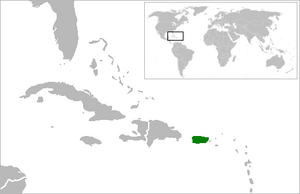List of non-marine molluscs of Puerto Rico facts for kids
The non-marine mollusks of Puerto Rico are amazing creatures like snails and slugs that live on land or in freshwater, not the ocean. Puerto Rico is an island with many different environments, from thick rainforests to dry coastal areas. This makes it a perfect home for a wide variety of these soft-bodied animals. They are a really important part of the island's wildlife.
These non-marine mollusks play a big role in Puerto Rico's ecosystems. They help with things like recycling nutrients, spreading seeds, and even become food for other animals like birds, mammals, and insects.
Contents
A Home for Many Species
Puerto Rico's diverse ecosystems, like lush rainforests and dry coastal areas, offer a rich home for many different non-marine mollusk species. This wide variety is due to the island's different landscapes and climates.
How They Live and Adapt
Non-marine mollusks in Puerto Rico have developed many ways to survive in their specific homes. For example, some species are perfectly suited for high-up cloud forests, while others do well in rainforests closer to sea level. Some can even be found living in towns and cities!
Unique Species of Puerto Rico
Just like many island ecosystems, Puerto Rico has several mollusk species that are found nowhere else on Earth. These unique species are called endemic species. They are super important to protect because they are often more at risk from things like losing their homes or changes in the environment.
Protecting These Creatures
Unfortunately, non-marine mollusks in Puerto Rico, like in many other places, face dangers. These include losing their homes, pollution, and climate change. Understanding and dealing with these problems is key to making sure these species survive for a long time.
Studying Mollusks
Scientists are always studying the non-marine mollusks of Puerto Rico. They want to learn more about how these animals live, what they do, and their role in nature. This knowledge is vital for protecting them and helps us understand bigger ideas about how ecosystems work.
Working Together for Conservation
There are many efforts to protect Puerto Rico's non-marine mollusks. These might involve restoring their habitats, breeding programs to help increase their numbers, and teaching people about how important these creatures are. Local conservation groups, government agencies, and international research groups often work together. Sharing what they know and their resources helps create better ways to protect these species.
Types of Mollusks in Puerto Rico
Scientists like Robert James Shuttleworth have described many new types of mollusks from Puerto Rico. In 1854, he identified 3 new groups (genera) and 25 new species!
Freshwater Snails (Gastropods)
- Tarebia granifera (Lamarck, 1822)
Land Snails (Gastropods)
- The group called Gaeotis Shuttleworth, 1854 is found only in Puerto Rico.
- Polydontes acutangula Burrow, 1815
- Succinea approximans Shuttleworth, 1854
- Veronicella portoricensis (Semper, 1885)
See also
- List of marine molluscs of Puerto Rico
Lists of molluscs of surrounding countries:
- List of non-marine molluscs of the United States
- List of non-marine molluscs of Dominican Republic
- List of non-marine molluscs of the Virgin Islands


